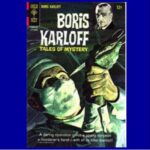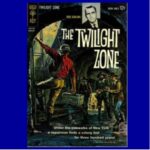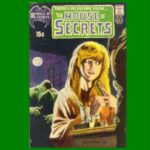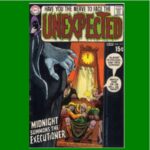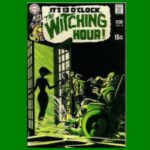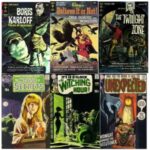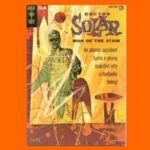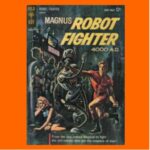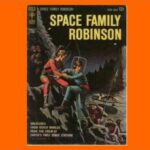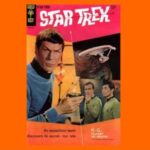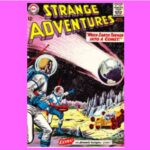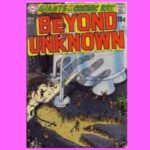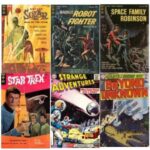Clicking on the following links or images will take you to the various Mystery/Horror and Science Fiction comic collections covered in this section:
This section contains an assortment of comics from two genres which deal with the world of imagination, but from different ends of the spectrum. The first is the realm of the supernatural (mystery and horror) while the other is in the realm of science and technology (science fiction). While growing up in the 1960s and 1970s, my favorite comics in each of these genres were from both Gold Key and DC. Thus, I have listed various mystery/horror and sci-fi comics from these publishers in this section.
Please see below for a brief summary of the different comic series covered in this section, separated by publisher and in order of the date of first publication.
Gold Key Comics
Boris Karloff: Tales of Mystery (1962): This was one of three comic books published by Gold Key starting in the 1960s which delved into the realm of horror and suspense. The series was inspired by the renowned actor Boris Karloff, known for his iconic roles in classic horror films. The comics featured chilling tales of mystery, often with supernatural or macabre elements. All the stories included short introductions by Boris Karloff himself, lending his legendary presence to the series and providing a personal connection to the stories.
Doctor Solar: Man of the Atom (1962): This was one of several sci-fi comics published by Gold Key, and one of the longest lasting. The main character Dr. Solar was a super-hero who possessed atomic powers, making him one of the first characters in comics to embody atomic energy. The stories in the comic book showcased Dr. Solar’s incredible powers, his relentless battles against villains, and his determination to protect humanity from atomic threats.
The Twilight Zone (1962): This was the second of three Gold Key mystery/horror comics of the 1960s. It was based on the iconic television series and was launched a few years after the TV show’s premiere. The comics featured original stories inspired by the show’s themes of science fiction, fantasy and psychological suspense, allowing readers to experience new mind-bending tales beyond the TV screen. All the stories included short introductions by Rod Serling, the creator and host of the TV show.
Space Family Robinson/Lost in Space (1962): This was another Gold Key sci-fi comic that debuted in the same year as Doctor Solar. The series followed the interstellar adventures of the Robinson family, who became stranded on a distant planet after their spaceship was thrown off course. It was linked to the popular TV show Lost in Space which aired around the same time. Both the comics and the TV show depicted the family’s efforts to survive in their new environment while facing alien creatures, exploring uncharted territories and seeking a way to return to Earth.
Magnus: Robot Fighter (1963): The third of the Gold Key sci-fi set, this comic featured the adventures of Magnus, a skilled martial artist trained to fight rogue robots in a futuristic world. The comic book was known for its unique blend of action, though-provoking themes and exploration of man’s relationship with technology. The stories showcased Magnus’s impressive combat skills, his determination to protect humanity, and his ongoing struggle against the dominance of robots.
Ripley’s Believe It of Not: Ghost Stories (1965): This was the last Gold Key horror comic book of the 1960s. Inspired by Robert Ripley’s popular newspaper feature, the comics adapted his unique brand of “strange but true” tales into a visually captivating format. Each issue featured a collection of oddities, freak occurrences and extraordinary ghost stories, presenting Ripley’s his unique brand of “strange but true” tales in a visually captivating format.
Star Trek (1967): One of the last of the Gold Key sci-fi comic books, it was arguably the best. The comic book was launched a couple of years after the original Star Trek TV series, and it lasted much longer than the TV series. Like the TV show, the comics featured the adventures of Captain Kirk and his crew of the USS Enterprise in the form of serialized episodes, providing fans with new interstellar missions and encounters. These comics played a significant role in expanding the beloved Star Trek franchise beyond the realm of television and establishing it as an enduring part of popular culture.
DC Comics
Strange Adventures (1950): This comic title had a long publication history that left a lasting impact on the world of sci-fi comics. The original series featured a mix of science fiction, fantasy, adventure and even horror. Around the time I started reading it in the late 1960s, it had transitioned into an anthology of reprinted sci-fi stories, including the recurring adventures of Adam Strange on the alien planet of Rann. The rebooted series celebrated the rich history of DC Comics, reintroducing classic sci-fi tales to a new generation of readers and captivating readers with its thrilling and imaginative storytelling.
The Unexpected (1967): This was another DC title that underwent a transition, but in the opposite direction to Strange Adventures. Originally known as Tales of the Unexpected, the series featured a mix of science fiction and fantasy stories. However, in 1967, the title underwent a significant transformation and became The Unexpected, signaling a shift towards darker narratives about the supernatural. The transition to horror stories brought a fresh and exciting direction to the series, allowing it to tap into the growing popularity of the horror genre during that time.
The Witching Hour (1969): This title was another part of DC’s repertoire of horror comics which started in the late 1960s. The comic book featured a collection of supernatural and occult-themed stories in each issue. The narratives often delved into the realms of witches, ghosts and other mystical entities. The comics often incorporated framing stories that by the three witch hosts, who provided an introduction and occasional commentary that added an extra layer of enchantment and foreboding to the comics.
The House of Secrets (1969): Just like The Unexpected, this comic title transitioned in the late 1960s from the realm of mystery and fantasy into the realm of horror, capitalizing on the growing popularity of the genre at the time. The comics introduced a character named Abel as the primary host of the series, similar to the witch hosts of The Witching Hour. Abel, a reanimated corpse, served as the perfect guide for readers as he shared spine-chilling tales of terror from the mysterious house.
From Beyond the Unknown (1969): This title directly started as an anthology reprint series of sci-fi stories, rather than transitioning into it like Strange Adventures. The series served as a treasure trove for sci-fi comic fans, reintroducing classic tales of science fiction mixed with mystery and adventure to a new generation of readers. These reprints exemplified the imaginative storytelling and engaging themes that defined the early days of comic-book science fiction.


